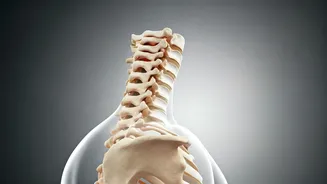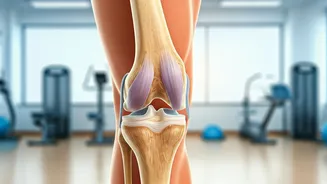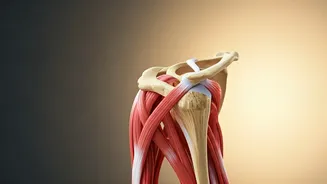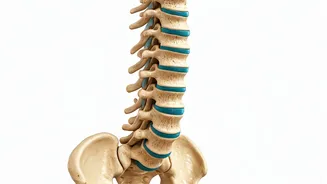Defining Tech Neck
Tech neck, in essence, is a modern-day malady stemming from the constant downward gaze we adopt while using smartphones, tablets, and laptops. This posture
involves the head tilting forward and the shoulders rounding, placing significant strain on the neck muscles and spine. Over time, this repeated strain can lead to discomfort, stiffness, and even more serious issues like headaches and nerve compression. Think of it as a digital slouch, where our bodies unconsciously adapt to the positions demanded by our devices. The more time spent hunched over, the more likely the development and intensification of tech neck becomes. Unlike traditional postural problems, tech neck is specifically linked to the technology we use daily, making it a prevalent concern in today's digital world.
Spotting the Symptoms
Recognizing the signs of tech neck is the initial step toward addressing it. Common symptoms include neck pain, stiffness, and soreness, often aggravated by prolonged screen time or specific movements. Headaches, particularly those originating at the base of the skull, can also signal tech neck. Some individuals experience shoulder pain and tightness, along with a rounded upper back posture. In more severe cases, tingling or numbness in the arms and fingers may occur due to nerve compression. Visual cues, such as a forward head posture or a pronounced curve in the upper back, are also key indicators. Paying attention to these symptoms and noticing changes in posture are important to catch tech neck early on and take proactive steps.
Preventative Measures
Preventing tech neck requires a conscious effort to adjust our habits and posture. Start by optimizing your workspace: Position your computer screen at eye level to avoid looking down. Ensure your chair provides adequate support for your back, and take regular breaks to stand up and stretch. Consider the '20-20-20 rule': every 20 minutes, focus on an object 20 feet away for 20 seconds. This helps alleviate eye strain and encourages a change in posture. Regularly stretch your neck and shoulders throughout the day, incorporating exercises that open up the chest and strengthen the back muscles. Practicing good posture while using your phone, by holding it at eye level, can significantly reduce strain. Regular exercise, especially activities that strengthen your core and back muscles, plays a vital role in maintaining good posture and preventing tech neck.
Treating Tech Neck
Addressing tech neck involves a combination of lifestyle adjustments and targeted treatments. Start by improving your posture consciously and making those changes habitual. Incorporate neck and shoulder stretches regularly to release tension. Gentle exercises, like chin tucks and shoulder blade squeezes, can help strengthen the muscles supporting your neck and upper back. Over-the-counter pain relievers can alleviate discomfort in the short term, but consult a doctor if the pain persists. Consider professional treatments like physiotherapy, which offers targeted exercises and posture correction techniques. Massage therapy can also help relieve muscle tension and improve circulation. In some cases, a healthcare professional might suggest ergonomic adjustments to your workspace or further investigation if symptoms persist. Always consult with a doctor or physical therapist for a personalized treatment plan.
Ergonomics and Tech
Proper ergonomics play a crucial role in preventing and managing tech neck. Assess your workspace: is your chair providing proper lumbar support? Is your desk at an appropriate height? Are your screens positioned at eye level? Make sure your keyboard and mouse are positioned to prevent straining your wrists and shoulders. Consider using an external keyboard and mouse with your laptop, which can improve posture. When using mobile devices, limit the amount of time spent looking down. Hold the device at eye level as much as possible, or use a phone stand. Encourage breaks from screen time to allow your muscles to relax and your eyes to rest. Implementing ergonomic principles into your daily digital routine is crucial for long-term comfort and preventing further injury.
Exercises for Relief
Specific exercises can greatly alleviate tech neck symptoms. Chin tucks are excellent for strengthening the neck muscles and improving posture. To perform these, gently tuck your chin towards your chest, as if creating a double chin, and hold for a few seconds, repeating several times. Shoulder blade squeezes involve squeezing your shoulder blades together, as if holding a pencil between them, while maintaining a neutral spine. Side neck stretches, where you gently tilt your ear towards your shoulder, holding the stretch for several seconds, can release tension. Chest stretches, such as clasping your hands behind your back and pulling your shoulders back, will help open up the chest and counteract the rounded posture caused by screen use. These exercises should be performed gently and regularly for optimal results. It is important to listen to your body and stop if any pain is felt.
Integrating Healthy Habits
Consistently implementing healthy habits makes a significant difference in preventing and managing tech neck. Take regular breaks from your screens to give your eyes and neck muscles a rest. Prioritize good posture, both at your desk and while using mobile devices. Develop the habit of stretching your neck and shoulders throughout the day, especially after prolonged screen use. Stay hydrated; drinking enough water helps maintain the elasticity of your muscles and reduces stiffness. Aim for regular exercise, including activities that strengthen your back and core muscles. Maintain a healthy lifestyle that promotes overall well-being. By combining these habits, you can create a daily routine that supports a healthy posture and reduces the risk of tech neck. Consistency is the key to seeing long-term improvements.











